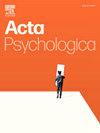Not mine, it's yours: Liberal decision threshold underpins self-other memory prioritization
IF 2.1
4区 心理学
Q2 PSYCHOLOGY, EXPERIMENTAL
引用次数: 0
Abstract
The Self-reference effect (SRE) is a well-established phenomenon of enhanced memory for self-associated stimuli. Previous research assumed the SRE is underpinned by an attentional boost enhancing early visual processing, as speculated in the Self-attention Network (SAN1). If so, self-relevance should counteract impaired memory for visually degraded stimuli (e.g., those presented at low contrast). In two experiments we investigated if the attentional enhancement attributed to the SAN occurs at the encoding (Experiment 1) or retrieval (Experiment 2) stage of recognition memory. Using a computerised version of the shopping task, participants sorted miscellaneous shopping objects into self- and other-owned bags (encoding) and then completed a surprise recognition source memory test, indicating if the object was self-, other-owned or not recognised (retrieval). Notably, in Experiment 1, half the objects appeared under low-contrast conditions during the object sorting task (encoding). Conversely, in Experiment 2 the low-contrast manipulation occurred in the subsequent surprise recognition source memory test. Contrary to previous findings, neither manipulation produced the SRE at the behavioural level, with equally accurate source memory for self- and other-owned objects. A Hierarchical Linear Ballistic Accumulator model probed the decisional mechanisms underlying memory performance. This model revealed a caution decision threshold for self- compared with other-owned objects potentially accounts for self-relevance memory advantages. This suggests decision-level factors contribute to the SRE and potentially play a larger role than early attentional factors.
不是我的,是你的:自由决策阈值支持自我-他人记忆优先排序
自我参照效应(Self-reference effect, SRE)是一种对自我相关刺激的记忆增强现象。先前的研究假设SRE是由一种增强早期视觉处理的注意力增强所支撑的,正如自我注意网络(SAN1)所推测的那样。如果是这样,自我关联应该抵消对视觉退化刺激(例如,低对比度呈现的刺激)的受损记忆。在两个实验中,我们研究了由SAN引起的注意增强是否发生在识别记忆的编码(实验1)或检索(实验2)阶段。使用电脑版本的购物任务,参与者将各种各样的购物物品分成自己拥有的和别人拥有的袋子(编码),然后完成一个意外识别源记忆测试,表明物品是自己拥有的、别人拥有的还是不认识的(检索)。值得注意的是,在实验1中,一半的对象在对象排序任务(编码)期间出现在低对比度条件下。相反,在实验2中,低对比度操作发生在随后的惊喜识别源记忆测试中。与先前的研究结果相反,两种操作都不能在行为水平上产生SRE,对自己和他人拥有的物体具有同样准确的源记忆。一个层次线性弹道累加器模型探讨了存储性能的决策机制。该模型揭示了一个谨慎的决策阈值,自我与他人拥有的对象相比,潜在地解释了自我相关记忆的优势。这表明决策水平因素对SRE有贡献,并且可能比早期注意因素发挥更大的作用。
本文章由计算机程序翻译,如有差异,请以英文原文为准。
求助全文
约1分钟内获得全文
求助全文
来源期刊

Acta Psychologica
PSYCHOLOGY, EXPERIMENTAL-
CiteScore
3.00
自引率
5.60%
发文量
274
审稿时长
36 weeks
期刊介绍:
Acta Psychologica publishes original articles and extended reviews on selected books in any area of experimental psychology. The focus of the Journal is on empirical studies and evaluative review articles that increase the theoretical understanding of human capabilities.
 求助内容:
求助内容: 应助结果提醒方式:
应助结果提醒方式:


